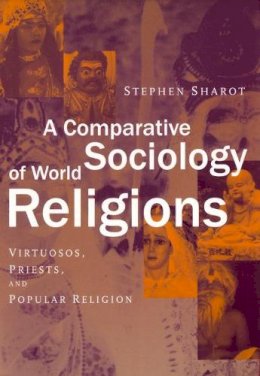10%OFF
Stock image for illustration purposes only - book cover, edition or condition may vary.
Comparative Sociology of World Religions
Stephen Sharot
FREE Delivery in Ireland
Description for Comparative Sociology of World Religions
Paperback. First book to offer a comparison of the popular, or folk, forms of religion around the world Num Pages: 353 pages, black & white illustrations. BIC Classification: HRAC; JH. Category: (P) Professional & Vocational; (UP) Postgraduate, Research & Scholarly; (UU) Undergraduate. Dimension: 5817 x 3887 x 22. Weight in Grams: 600.
A Sociology of World Religions presents a comparative analysis of the world's religions, focusing on the differences and interrelationships between religious elites and lay masses. In each case the volume contextualizes how the relationships between these two religious forms fit within, and are influenced by, the wider socio-political environment.
After introducing the book's major themes, the volume introduces and builds upon an analysis of Weber's model of religious action, drawing on Durkheim, Marxist scholars, and the work of contemporary sociologists and anthropolgists. The following chapters each focus on major religious cultures, including Hinduism, Buddhism, Catholicism, Protestantism, Islam, Judaism, ... Read moreand the religions of China and Japan. This ambitious project is the first to offer a comparison of the popular, or folk, forms of religion around the world.
Sharot's accessible introductions to each of the world religions, synthesizing a vast literature on popular religion from sociology, anthropology, and historians of religion, make the project ideal for course use. His comparative approach and original analyses will prove rewarding even for experts on each of the world religions.
Show Less
Product Details
Publisher
New York University Press United States
Place of Publication
New York, United States
Shipping Time
Usually ships in 7 to 11 working days
About Stephen Sharot
Stephen Sharot is Professor of Sociology at Ben-Gurion University of the Negev, and has been Visiting Associate Professor of Sociology at Chapel Hill, and at SUNY Stony Brook. He is the author of Judaism: A Sociology and Messianism, Mysticism, and Magic: A Sociological Analysis of Jewish Religious Movements (winner of the Kenneth B. Smilen/Present Tense Literary Award) and coauthor of ... Read moreEthnicity, Religion, and Class in Israeli Society. Show Less
Reviews for Comparative Sociology of World Religions
..the book reads smoothly and continues to engage the reader's attention. This book belongs in libraries of all sorts. It strikes me as a paradigm of analytical comprehension that should set a standard for the field.
Journal for the Scientific Study of Religion,September 2002
A triumphant successof well-marshalled resources, careful argument, and lucid discussion. Sharot brings to his ... Read morework a dauntingindeed dazzlingarmoury of cross-cultural scholarship, impressively matched by rigorous, sustained and penetrating analysis. The book is not only a monumental contribution to our understanding of religion world-wide, but is also an exemplary exploitation of the insights of sociological analysis when applied to widely diverse cultural phenomena.
Bryan Wilson,Emeritus Fellow of All Souls, University of Oxford, U.K., and author of Religion in Sociological Perspective Sharot makes a substantial contribution to the maturation of the comparative sociology of religion. A distinctive feature of the book is its accent on popular religion, a much studied phenomenon these days.
Martin Marty The many books on the world's religions typically emphasize doctrine ( religion "in the air"), while sociology of religion books typically emphasize behavior (religion ‘on the ground’). Stephen Sharot does both in this masterful study, the product of many years of research. His book should have great classroom potential as well as a prominent place on religion scholars' bookshelves.
Phillip Hammond D. Mackenzie Brown,Professor of Religious Studies, Department of Religious Studies, University of California Santa Barbara This book belongs in libraries of all sorts. It strikes me as a paradigm of analytical comprehension that should set a standard for the field.
Journal for the Scientific Study of Religion,September 2002
Show Less

